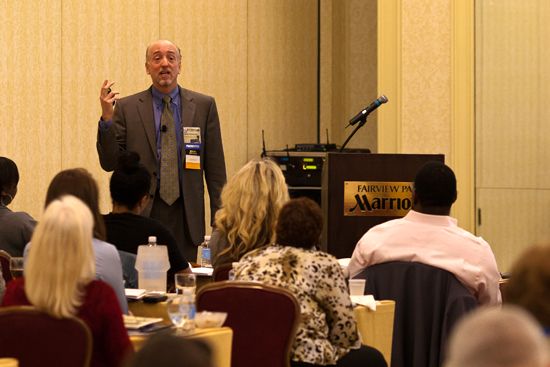
What’s a Proposal Theme and Why is it Important? (Part 1)
- 1.How to Create Great Proposal Themes
- 2.What’s a Proposal Theme and Why is it Important? (Part 1)
- 3.How to Create Great Proposal Themes (Part 2): Features and Benefits
- 4.How to Create Great Proposal Themes (Part 3): The Proof is in the Pudding
- 5.How to Create Great Proposal Themes (Part 4): A Method for the Madness
- 6.How to Create Great Proposal Themes (Part 5): Who You Gonna Call?
- 7.Telling Your Story: Compliant and Compelling Proposal Themes that Win
Very few teams take the time to identify the features, benefits, and supporting proof in sufficient detail to…win
When you think about it, proposal writing is really about telling a story. A story about how your solutions to problems are better than your competitors’ in ways that really matter to your customers.
All too often, the story is written by authors who are responsible for different chapters (sections), with no clear idea of the setting (understanding the need), the characters (key personnel), the plot (solution), the ending (customer benefits), or the moral of the story (themes).
When the proposal manager puts all of the sections together for the first time (Pink Team) it’s no wonder that the feedback is all too predictable: “solutions not clearly articulated”, “claims are unsubstantiated”, and “compelling themes and differentiators are missing”.
Most proposal teams understand the value of developing themes as the basis for telling their story. However, very few teams take the time to develop the features, benefits, and supporting proof in sufficient detail to achieve the happy (winning) ending they desire.
A Theme or a Dream?
Many capture managers and sales executives are quick to describe how well they know their prospective customers, that they are uniquely positioned to win new business, and that they have defined the themes the proposal team needs to write a winner. More often than not, these so called win themes are nothing more than vague, generalized statements that hardly distinguish their well-positioned company from any other bidder.
The following win themes were posted on the war room wall of one of my customers pursuing a $2 billion contract (code name: DreamThemes), and serve as a vivid example of what win themes are NOT.
Proposal Win Themes?
- Best value
- No risk
- We understand you – better than anyone else
- CMMI Level 3 best practices
- Relevant past performances
- Superior technical solution
The DreamThemes were literally dreamt up by the capture team during a lunch meeting. These ‘win themes’ lack the detailed features, benefits, and proof required for a complete and compelling proposal. Posting them on the proposal room wall brainwashed the team into thinking that they had a winning approach and were ready to write. After taking over responsibility for the management of this proposal, we quickly developed a more compliant and compelling set of themes. We were under extreme time pressure and had to limit the theme development process to a focused 2-day effort. Despite heroic efforts, we weren’t sure our themes were compelling enough to win.
In stark contrast, another one of my customers (code name: MeanThemes) insisted on spending over two weeks developing a 15 page theme document. The MeanThemes document included five high-level win themes with 4-6 proposal volume-specific sub-themes for each, and scores of section and requirement-level themes, with detailed features, benefits, and differentiating proof statements at each thematic level. The MeanThemes were shared across the entire proposal team. They provided high-level guidance to the writers, and served as basis for an Executive Summary that virtually wrote itself. We were all convinced that we had developed a very comprehensive set of proposal themes, and were confident we were on the path to a winning proposal. See the author note at the end of Part 1 to see what happened to DreamThemes and MeanThemes. The result may surprise you.
What’s a Theme?
A proposal theme is commonly defined as a “central idea (feature and benefit) that is supported or proved”. Most proposal experts generally agree that themes and supporting proof-point discriminators (or more politically correct ‘differentiators’) are the MOST EFFECTIVE way to distinguish your proposal from the competition (other than price).
Themes are really the fundamental building blocks for telling your story. Themes are not sales slogans. Most slogans are easy to remember catch phrases like the popular Washington Post slogan: “If you don’t get it…you don’t get it”. This slogan is easy to remember, but lacks any real subscriber features, related benefits and supporting proof such as readability, cost, readership, breadth and depth of content, customized subscriber packages, and so on.
What’s a Win Theme?
The term ‘win theme’ is commonly used throughout the proposal industry. The use (or misuse) of this term contributes to the general confusion about themes. Win themes are higher-level (meta theme) features and benefits that transcend the entire proposal. Effective proposals usually have no more than one or two win themes that are focused on what customers care about the most things like increased efficiency (faster), increased effectiveness (better), lower cost (cheaper), and lower risk (safer). The trick is to develop a hierarchy of proposal, volume, and requirement-level themes, with increasing levels of detail, to support each high-level win theme.
What’s a Proposal Theme?
When capture and proposal managers refer to win themes, chances are they really mean proposal themes. Most win themes are really proposal themesfeature and benefit statements with supporting proof points at the volume, section, sub-section, and even paragraph levels. Proposal themes are much more specific than win themes. They usually appear as a highlighted first sentence (in a proposal volume or section) and serve as a mini-summary of the subsequent narrative. Well-written proposals have themes at the beginning of every paragraph and in the action captions of all graphics.
Volume themes are proposal themes that typically focus on technical, management, past performance, cost, or other volume subjects. Section themes are themes that focus on section topics within each volume, for example, management approach, key personnel, quality, and risk, in the management volume. Requirement themes are themes focused on the most detailed requirement topics in each section like those in the statement of work, performance work statement, or other comprehensive requirements specification.
Why are Themes Important?
Proposal themes answer the evaluator’s most important question: “Why should we select you?” Volume, section, and requirement themes support the win themes by sending an explicit message to evaluators that is repeated over and over in subtle and not so subtle ways throughout the proposal. Well-written themes provide clear and convincing reasons for capturing the attention (and ultimately the imagination) of evaluators.
When evaluators finish reading their assigned sections, the alignment of solution features with customer benefits and supporting proof points leave no room for doubt, confusion, or skepticism. The bottom line—your proposal is easier to evaluate, tells a compelling story, using clearly articulated themes that score the most points.
Author Note: Remember the DreamThemes and MeanThemes examples? Despite their early win theme challenges, DreamThemes (2-day theme rush job) won the $2 billion dollar multiple-award Blanket Purchase Agreement and was the only new entrant bidder selected in a group previously dominated by incumbents. Ironically, MeanThemes (comprehensive multi-week theme development effort) lost their $40 million single award to a lower-risk technical solution with a significantly higher price. The winner was the incumbent. What’s the moral of the story? Sometimes even the best proposals, with compliant and compelling themes can’t overcome some overriding factors like incumbency and price.



